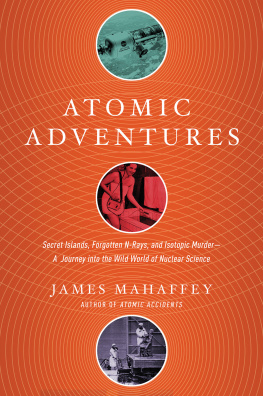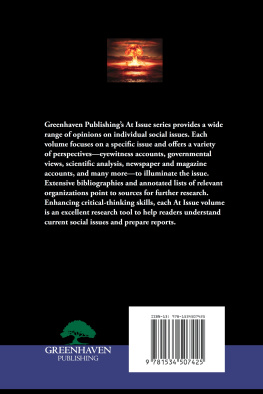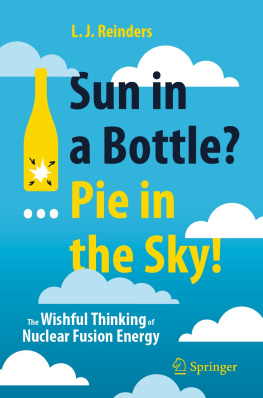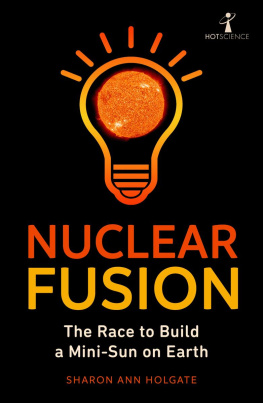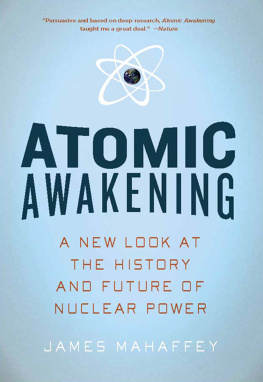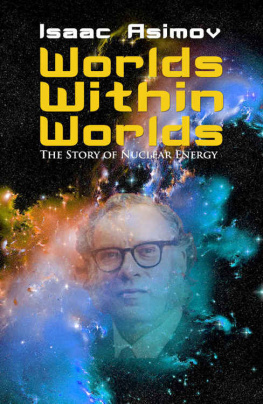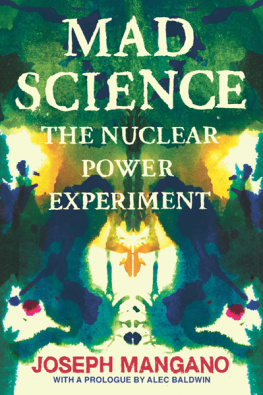
ALSO BY THE AUTHOR
Atomic Accidents
Atomic Awakenings

ATOMIC ADVENTURES
Pegasus Books Ltd.
148 W. 37th Street, 13th Floor
New York, NY 10018
Copyright 2017 James Mahaffey
First Pegasus Books edition June 2017
Interior design by Maria Fernandez
All rights reserved. No part of this book may be reproduced in whole or in part without written permission from the publisher, except by reviewers who may quote brief excerpts in connection with a review in a newspaper, magazine, or electronic publication; nor may any part of this book be reproduced, stored in a retrieval system, or transmitted in any form or by any means electronic, mechanical, photocopying, recording, or other, without written permission from the publisher.
Library of Congress Cataloging-in-Publication Data is available.
ISBN: 978-1-68177-421-3
ISBN: 978-1-68177-480-0 (e-book)
Distributed by W. W. Norton & Company, Inc.
www.pegasusbooks.us
Written in memory of
Dr. Monte V. Davis
Adviser, mentor, and friend.
He would have liked it.
Contents
A S THE TWENTIETH CENTURY DAWNED in Georgia, there remained two sure sources of income left over from the antebellum days: growing cotton and draining the sap out of pine trees. These two commodities, cotton fiber and turpentine, sold well to the industrial northern states, but to dress them up for sale required steel straps to bind the bales and steel hoops to hold the barrels together. The closest place to buy these necessary items was in Pennsylvania.
Finding this situation unacceptable, a mortgage broker in Atlanta, George Washington Connors, sold the concept of building a steel mill to a group of enthusiastic investors, and in 1901 the Atlanta Steel Hoop Company was formed. An old farm north of the city was the perfect place for it. The land, which had been fought over one afternoon in the summer of 1864 in the Battle of Peachtree Creek, was purchased from the brothers Kontz, A. L. and E. C., and Captain James W. English. The site was cleared; a sprawling complex of buildings, steam engines, and open-hearth furnaces was erected; and a railroad spur was laid. A workforce of 120 men was hired. Soon 50 tons of steel, formed into the desired articles, were rolling out of the mill per year, and Atlanta rejoined the industrial world after thirty-seven years of sleep following the Late Unpleasantness.
By 1907 the company was in explosive expansion, and the name was changed to Atlanta Steel Company. There were now more than one thousand people drawing pay at the plant. Good times rolled, and steel hoops, bands, nails, rivets, welding rods, rebars, and Dixisteel barbed wire piled high at the loading platform. Most hirelings lived within walking distance in the Home Park neighborhood that had sprung up south of the plant, from Fourteenth Street down to Sixth, with the main north-south venue being Kontz Street. It became the northernmost suburb of Atlanta, and as automobiles started being used for transportation, the streets were even paved. North of the plant, the deer still roamed.
Downtown was hustling and jiving, with a new vaudeville theater, the Forsyth, built at the corner of Forsyth and Luckie in 1911. Always striving to beat the Atlanta Theater over on Edgewood Avenue, the Forsyth Theater was pleased to snag a one-week engagement of the world-famous Harry Houdini, extraordinary magician and escape artist, starting April 19, 1915.
Houdini was a truly rare event. The Handcuff King worked the Orpheus Circuit, which usually ranged west all the way to San Francisco, north to Boston, and south as far as Richmond, when he wasnt entertaining Europe or Australia. To reach the masses in suburban Atlanta, some face time was in order. He hired a mule-drawn flatbed wagon on which he and his assistants could stand and perform. On Sunday, April 18, after church let out and lunch had been eaten, he parked it on the east side of Kontz Street, halfway between Sixth and Tenth Streets, where the steep hill was briefly interrupted by a flat, vacant lot. Across the street was the big, normally muddy backyard of the house at Sixth and Kontz. An artesian well in back of the house, fed by an underground tentacle of Peachtree Creek running north, kept the area in semi-swamp mode.
Harry Houdini stood on the wagon, rolled up his sleeves, and started shuffling cards. Soon, a small wad of curious wanderers collected in front of the wagon. Word spread rapidly by speedy-foot telegraph through the Home Park community. Some Yankee was giving a free magic show up on Kontz! The crowd, hushed and spellbound, grew to hundreds, taking up the entire backyard across the street. Children were hoisted to shoulders so that they could see, and women were asked to remove their hats. There is no record of what tricks the great magician performed that day, but he was over his handcuff-escape phase and was probably showing off with cards and his new East Indian needle trick.
He first swallowed a handful of needles, one at a time, sometimes having dramatic trouble getting them down. There were at least thirty-five needles of various sizes, up to two and a quarter inches long. He then ate a length of thread, which was actually a five-foot-long piece of highly visible white twine, swallowing a couple of inches per gulp. He paused for a second to settle his stomach, then searched around in his mouth with a digit, seemed to discover something by feel, then slowly withdrew the thread, held delicately between his thumb and forefinger. The string was so long, a couple of assistants had to support it as it slowly emerged. The needles were spaced at random intervals, hanging on the string. He had apparently regurgitated the needles and threaded them onto the string with his tongue. The crowd was amazed, and Houdini enjoyed sellout crowds at the Forsyth.
That December, the name of the mill was changed to the Atlantic Steel Company, and Kontz was renamed Atlantic Drive. World Wars I and II came and went, and the fortunes of Atlantic Steel grew as the demand for Dixisteel products increased. By 1952, 2,100 people were working at the mill. At that time the Georgia School of Technology, headquartered down on North Avenue, was striving to become a research university and was buying up property north of Sixth Street.
The change of technology from simple to complex had been in effect since a person picked up the first rock and found it useful for cracking walnuts. In the 1950s, the movement seemed to accelerate. While the steel plant, built with the most advanced nineteenth-century mechanisms, faded into the heavy industry landscape, the feisty trade school on North Avenue loomed large. The name was changed to the Georgia Institute of Technology. In 1954, the governor of Georgia appointed a Tech graduate, Frank H. Neely, forward-looking industrialist and the head of Richs department store, as chairman of the Georgia Nuclear Advisory Commission. Under aggressive prodding by Neely, Georgia Tech built the Radioisotopes Laboratory Facility at the southeast corner of the intersection of Sixth and Atlantic Drive in 1959, and plans for a large nuclear research reactor were laid down. The old house at the top of the hill on Atlantic was demolished, and the Electronics Research Building was erected with the parking lot paved directly over the artesian well, ensuring that there would always be a curious wet spot there. Sixth Street was renamed Ferst Street.
Behind the Electronics Research Building, right over the spot where the crowd had congregated to see Houdini on a fine April afternoon, a large hole was excavated, down to bedrock. Here was planted the Frank H. Neely Nuclear Research Reactor, a multipurpose neutron source, designed by the General Nuclear Engineering Corporation in Dunedin, Florida. The main building was a gleaming white steel cylindrical structure with a domed top, connected to a two-story annex having offices, a classroom, laboratories, and special shops for nuclear work. It was issued an operating license, no. R-97, by the Atomic Energy Commission on December 29, 1964, and proceeded to entertain with its own form of magic, doing tricks that would have baffled Houdini on a daily basis, doing everything from driving a LASER cavity with neutrons to investigating Legionnaires Disease.
Next page
